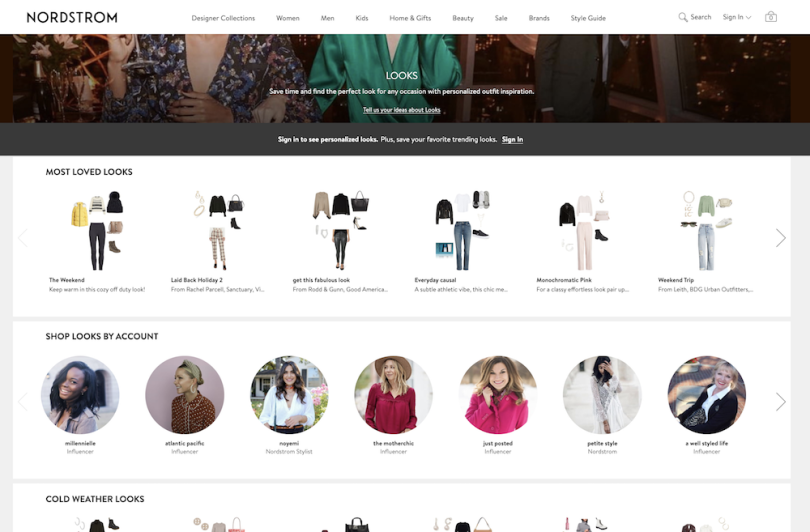With a smartphone in every pocket, we’re able to do a lot from just about anywhere. Work, communicate, manage finances, access humanity’s collective knowledge — and shop, shop, shop. That accessibility means traditional retailers, long accustomed to serving people in-store and advertising sales through TV ads, have had to adapt to this new shop-from-anywhere culture or drift into obscurity.
Take Nordstrom. The company operates 380 stores, ranging from its high-fashion department stores to styling services and off-price outlets. In recent years, the company’s made big investments in its online presence to complement innovations in how it thinks about the physical store experience.
4 Ways Retailers Are Changing With the Times
- Gap, Nordstrom, JCPenney and Macy’s resell second-hand clothing
- Macy’s, JCPenney and Sears have closed large department stores in favor of smaller locations and online sales
- Adidas and Nike have used AR to launch new products
- Some brands are creating stylist consultation locations — like Nordstrom Local, which comes complete with wine, manicures, coffee and online pickup services
“One of the things that I find interesting is the bridge between the physical — where we’re delivering products to customers — and the digital,” said Jacob Ulrich, a software engineer supporting the Seattle retailer’s iOS app. “It’s not just about solving an app problem — it goes much deeper. You’ve got to consider distribution and inventory counts, for example.”
Nordstrom engineers have shipped a number of digital products over the years, including an app feature that alerts customers when an item in their wish list is restocked or marked down. Ulrich spent the last six months working on that project. Meanwhile, veteran developer Shangfan Tu worked as an engineering manager on the team that put together Nordstrom’s “Looks” feature, which combines stylists’ expertise with customer preferences to create complete outfits digitally. Together, the two projects offer a glimpse into how traditional retailers like Nordstrom are embracing tech and the role engineers play in the process.

Creating the Looks product meant blending the expert eye of Nordstrom’s stylists with the individual preferences of its customers. In this process, stylists use software to design various outfits for casual, formal and other occasions. Within the framework of a given look, customer preferences and inventory availability dictate individual variations.
“For example, we have some looks that include T-shirts,” Tu said. “But if that particular shirt is sold out and we want to maintain the look, we use visual similarity defined by computer vision to find and substitute similar products.”
Users provide input by viewing, liking and interacting with different looks, which Nordstrom follows using streaming platforms.
“When they add an item to their cart and make the purchase, we are actively listening to those activities online,” Tu said. “Then those activities sync to our machine learning algorithms to help train them and optimize those recommendations.”
While individual customer preferences and underlying technology plays an important role in this feature, Tu pointed out that it mainly relies on Nordstrom’s stylists to guide its recommendations. The company has a fleet of fashionistas on staff, and building a product around their experience plays to the retailer’s strengths.
“We have a lot of human expertise to leverage,” she said. “If you’re training the machine learning to style, these stylists are the main people we want to learn from. Their input is pretty much how we train our machine learning.”
After almost two years on Looks, Tu recently moved to Nordstrom’s “personalization and recommendations” team, supporting the company’s webpage and mobile app. Her new team provides personalized product recommendations based on how customers engage with different products online.
“We have to bring this personalization system into our UI to track customer activities and offer our recommendations, and we have machine learning that can adjust based on customers’ preference changes,” she said. “The next step is to go deeper into the model and find a more scalable way to do personalization.”
It’s one of the most frustrating phrases in e-commerce: “That item is out of stock.”
And it’s not much fun for retailers, either. The work Tu and her team do on delivering outfit recommendations won’t help boost sales if the items they recommended aren’t in the company’s inventory in the first place.
That’s where Ulrich’s iOS app team comes in — the team who recently shipped the feature for opting in to wish list notifications.
“One of the big considerations is coordination across teams,” Ulrich said. “There’s a lot of data that we need to enable this feature.”
Those data sets include the items a customer is interested in, when a SKU might change, when a price drop occurs and when an item comes back in stock. To track them all, Nordstrom uses a number of event-streaming technologies, including Apache’s Kafka Streams.
“The main challenge was figuring out how to get the data feed internally, and in an efficient way,” Ulrich said. “Our goal was to get something out there that people could easily toggle on and get those notifications in real time.”
Ulrich said his team was cognizant of the fact that, for users who opted in, this feature would introduce a new flurry of alerts in a world chock-full of notifications. The team debated quiet hours, or introducing certain periods of time when notifications would come through.
“One type of future development will be to leverage customer activity and data in the store, and have that data available to train our model as well.”
However, prices can drop and shipments can arrive at all hours of the day — and that’s before considering odd hours when users might be online shopping.
“We ultimately decided that it’s a real-time event,” Ulrich said. “Should we have some kind of quiet-hour window in which you don’t get the notification, then there’s always a problem of stale data. If we delay those types of things, maybe the price has gone back up by the time they see it.”
The company is also exploring more ways to bridge the gap between users’ screens and Nordstrom’s physical locations.
“We want to branch those and create a connected experience,” Tu said. “One type of future development will be to leverage customer activity and data in the store, and have that data available to train our model as well.”





